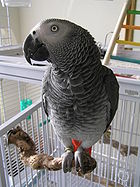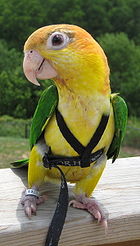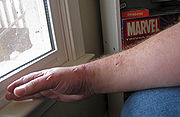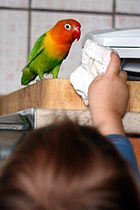
Companion parrot
Encyclopedia

Parrot
Parrots, also known as psittacines , are birds of the roughly 372 species in 86 genera that make up the order Psittaciformes, found in most tropical and subtropical regions. The order is subdivided into three families: the Psittacidae , the Cacatuidae and the Strigopidae...
kept as a pet
Pet
A pet is a household animal kept for companionship and a person's enjoyment, as opposed to wild animals or to livestock, laboratory animals, working animals or sport animals, which are kept for economic or productive reasons. The most popular pets are noted for their loyal or playful...
that interacts abundantly with its human counterpart. Generally, most species of parrot can make good companions.
Species of parrots that are kept as companions include large parrots such as Amazons
Amazon parrot
Amazon parrot is the common name for a parrot of the genus Amazona. These are medium-size parrots native to the New World ranging from South America to Mexico and the Caribbean....
, African Greys
African Grey Parrot
The African Grey Parrot , also known as the Grey Parrot, is a medium-sized parrot found in the primary and secondary rainforest of West and Central Africa. Experts regard it as one of the most intelligent birds. They feed primarily on palm nuts, seeds, fruits, leafy matter, but have been observed...
, Cockatoo
Cockatoo
A cockatoo is any of the 21 species belonging to the bird family Cacatuidae. Along with the Psittacidae and the Strigopidae , they make up the parrot order Psittaciformes . Placement of the cockatoos as a separate family is fairly undisputed, although many aspects of the other living lineages of...
s, Eclectus
Eclectus Parrot
The Eclectus Parrot, Eclectus roratus, is a parrot native to the Solomon Islands, Sumba, New Guinea and nearby islands, northeastern Australia and the Maluku Islands...
, Hawk-headed Parrots
Red-fan Parrot
The Red-fan Parrot , also known as the Hawk-headed Parrot, is an unusual New World parrot hailing from the Amazon Rainforest...
, and Macaw
Macaw
Macaws are small to large, often colourful New World parrots. Of the many different Psittacidae genera, six are classified as macaws: Ara, Anodorhynchus, Cyanopsitta, Primolius, Orthopsittaca, and Diopsittaca...
s; mid-sized birds such as Caique
Caique
The Caiques are species of parrots in the genus Pionites. There are two main species, the White-bellied Parrot and the Black-headed Parrot . They are relatively small and stocky, with a short, square tail. Due to their very brght, pure colors they are considered among the more beautiful parrot...
s, Conure
Conure
Conures are a diverse, loosely-defined group of small to medium-sized parrots. They belong to several genera within a long-tailed group of the New World Parrot subfamily Arinae. The term "conure" is used primarily in bird keeping, though it has appeared in some scientific journals...
s, Quakers
Monk Parakeet
The Monk Parakeet, also known as the Quaker Parrot, is a species of parrot, in most treatments the only member of the genus Myiopsitta. It originates from the temperate to subtropical areas of Argentina and the surrounding countries in South America...
, Pionus
Pionus
Pionus is a genus of medium-sized parrots native to Mexico, and Central and South America. Characteristic of the genus are the chunky body, bare eye ring , and short square tail. They are superficially similar to Amazon parrots, but smaller and in flight their wing-strokes are far deeper...
, Poicephalus
Poicephalus
The genus Poicephalus comprises nine species of parrots native to various regions of the Afrotropic ecozone, including Sub-Saharan Africa, ranging from Senegal in the west, Ethiopia in the east, and to Cape Horn in the south...
, Rose-ringed parakeet
Rose-ringed Parakeet
The Rose-ringed Parakeet , also known as the Ringnecked Parakeet, is a gregarious tropical parakeet species that has an extremely large range. Since the trend of the population appears to be increasing, the species has been evaluated as Least Concern by IUCN in 2009.Rose-ringed parakeets are...
s, and Rosella
Rosella
A rosella is one of five to eight species of colorful Australian parrots in the genus Platycercus. Platycercus means "broad-tailed" or "flat-tailed", reflecting a feature common to the rosellas and other members of the broad-tailed parrot tribe...
s, and many of the smaller types including Brotogeris
Brotogeris
Brotogeris is a genus of small parrots endemic to Central and South America. The closest relative is the Monk Parakeet. They eat seeds and fruit.-Taxonomy:List of species of the genus:* Plain Parakeet, Brotogeris tirica...
, Budgies
Budgerigar
The Budgerigar , also known as Common Pet Parakeet or Shell Parakeet informally nicknamed the budgie, is a small, long-tailed, seed-eating parrot, and the only species in the Australian genus Melopsittacus...
, Cockatiel
Cockatiel
The Cockatiel , also known as the Quarrion and the Weiro, is the smallest cockatoo endemic to Australia. They are prized as a household pet and companion parrot throughout the world and are relatively easy to breed...
s, Parakeets, Lovebird
Lovebird
A Lovebird is one of nine species of the genus Agapornis . They are a social and affectionate small parrot. Eight species are native to the African continent, while the Grey-headed Lovebird is native to Madagascar...
s, Parrotlet
Parrotlet
Parrotlets are a group of the smallest New World parrot species, comprising several genera, namely Forpus, Nannopsittaca, and Touit. They have a stocky build and a broad tail, much like the lovebirds of East Africa and fig parrots and pygmy parrots of Australasia...
s and Lineolated Parakeets.
Some species of lories and lorikeets are kept as pets but are quite messy, and often more popular as aviary
Aviary
An aviary is a large enclosure for confining birds. Unlike cages, aviaries allow birds a larger living space where they can fly; hence, aviaries are also sometimes known as flight cages...
birds. Hanging parrot
Hanging parrot
The hanging parrots are birds in the parrot genus Loriculus . This is a group of small parrots from tropical southern Asia.These little parrots, about 13 cm long, are mostly green plumaged and short-tailed. Often head coloring helps to identify individual species...
s, and Fig parrot
Fig parrot
Fig parrots is a small tribe with two small genera of parrots of the Psittacidae family found in Indonesia, Papua New Guinea, and tropical Australia...
s are normally kept as aviary birds and not as pets. Some species as Pygmy parrot
Pygmy parrot
Pygmy parrots are the smallest members of the parrot family. There are six species of pygmy parrot; all in the genus Micropsitta, which is the only genus in the Micropsittini tribe....
s and Kakapo
Kakapo
The Kakapo , Strigops habroptila , also called owl parrot, is a species of large, flightless nocturnal parrot endemic to New Zealand...
s, Night Parrot
Night Parrot
The Night Parrot is a small broad-tailed parrot endemic to the continent of Australia. The species was originally placed within its own genus , but most authors now prefer to place it within the genus Pezoporus together with the two ground parrots.No known sightings of the bird were made between...
s, and about half of the species of parrotlet, are not considered companion parrots due to difficult dietary requirements or unavailability.
The Convention on International Trade in Endangered Species of Wild Fauna and Flora (also known as CITES) has made the trapping and trade of all wild parrots illegal, because taking parrots from the wild has endangered or reduced some of the rarer or more valuable species. However, many parrot species are still common; some abundant parrot species may still be legally killed as crop pests in their native countries.
Endangered
Endangered species
An endangered species is a population of organisms which is at risk of becoming extinct because it is either few in numbers, or threatened by changing environmental or predation parameters...
parrot species are better suited to conservation
Conservation biology
Conservation biology is the scientific study of the nature and status of Earth's biodiversity with the aim of protecting species, their habitats, and ecosystems from excessive rates of extinction...
breeding programs than as companions.
Maintenance
_-cage_bars.jpg)
Pellets & Formulated Diets
In more recent years, pellets or formulated diets have become very popular, especially in the US. They offer an advantage over a seed-based diet in that a parrot cannot pick out and eat only its favorite (usually fatty) seeds. The majority of avian veterinarians will recommend a pelleted or formulated diet, and will extensively discuss with owners what their bird should and should not eat However, although these offer an easy alternative to other foods, they are not the best for many species. Many pellets contain artificial food dyes and preservatives that may be harmful; however there are "no-color-added" options available on the market. Most pellets contain soy, which is not a part of a parrot's natural diet; however, the diet of wild parrots cannot be replicated in captivity. Avian veterinarians and nutritionists agree the pelleted and formulated diets are the best base diet for pet birds. Although pellets may be advertised as a "complete diet," there are dozens of species of parrots commonly kept as pets, all with varying nutritional needs. There are still many birds which develop problems such as vitamin toxicity, fatty liver disease or gout, despite being on a pelleted diet. A common mistake made by owners feeding pellets is over-supplementing them with fresh food. As a pellet is, essentially, a supplemented grain, supplementing them even more "dilutes" the diet, making the pellets less efficient and the diet unbalanced. The best diet for a bird should be determined by an avian veterinarian.As pets

Most pet parrots take readily to trick training. Trick training can also help to redirect a bird's energy and prevent or correct many behavior problems. Some owners successfully use well behaved parrots as therapy animals. Some owners have trained their parrots to wear parrot harness
Parrot harness
A parrot harness or bird flight harness may enable a tame pet or companion parrot to be taken outdoors, but some parrots may dislike wearing a harness and bite at it. Parrots that are harness trained from a very young age may accept them willingly, but more often, parrots must be very carefully...
es (most easily accomplished with young birds) so that they can be taken to enjoy themselves outdoors in a relatively safe manner without the risk of flying away. Parrots are prey animals and even the tamest pet may fly off if spooked.
Although parrots can be messy pets—often throwing food and damaging furniture with their beaks if they can—most parrots may be potty trained to some extent and are generally odorless; however, certain species of Amazons and Pionus have a distinctive odor most owners find pleasant. Most parrot species, with some notable exceptions, are relatively good pets for most pet allergy sufferers. However, all the species of white cockatoos produce large quantities of dust from their powder down feathers, which may be problematic for people with allergies. Cockatiels, rose-breasted cockatoos, and African greys also produce smaller amounts of feather dust.
Behavior
_-chewing_wood.jpg)
Many of the larger parrots are unsuitable in an apartment setting due to noise level. Although all parrots will make some noise, species that are generally less noisy include parrotlet
Parrotlet
Parrotlets are a group of the smallest New World parrot species, comprising several genera, namely Forpus, Nannopsittaca, and Touit. They have a stocky build and a broad tail, much like the lovebirds of East Africa and fig parrots and pygmy parrots of Australasia...
s, budgie
Budgerigar
The Budgerigar , also known as Common Pet Parakeet or Shell Parakeet informally nicknamed the budgie, is a small, long-tailed, seed-eating parrot, and the only species in the Australian genus Melopsittacus...
s, cockatiel
Cockatiel
The Cockatiel , also known as the Quarrion and the Weiro, is the smallest cockatoo endemic to Australia. They are prized as a household pet and companion parrot throughout the world and are relatively easy to breed...
s, Pyrrhura
Pyrrhura
Pyrrhura is a genus of parrots in the Arini tribe. They occur in tropical and subtropical South America and southern Central America . Most are restricted to humid forest and adjacent habitats, but one species, the Blaze-winged Parakeet, prefers deciduous or gallery woodland, and another, the...
conures, Pionus
Pionus
Pionus is a genus of medium-sized parrots native to Mexico, and Central and South America. Characteristic of the genus are the chunky body, bare eye ring , and short square tail. They are superficially similar to Amazon parrots, but smaller and in flight their wing-strokes are far deeper...
, caique
Caique
The Caiques are species of parrots in the genus Pionites. There are two main species, the White-bellied Parrot and the Black-headed Parrot . They are relatively small and stocky, with a short, square tail. Due to their very brght, pure colors they are considered among the more beautiful parrot...
s, African Greys, and usually Poicephalus
Poicephalus
The genus Poicephalus comprises nine species of parrots native to various regions of the Afrotropic ecozone, including Sub-Saharan Africa, ranging from Senegal in the west, Ethiopia in the east, and to Cape Horn in the south...
. Many of the other species of conures can be loud birds. Cockatoos, and many Macaws and Amazon parrot
Amazon parrot
Amazon parrot is the common name for a parrot of the genus Amazona. These are medium-size parrots native to the New World ranging from South America to Mexico and the Caribbean....
s can be very loud, though normally only at certain times of the day and some birds will learn to scream for attention.
Many people are initially attracted to parrots for their ability to talk, sing, and mimic noises they are exposed to. Some parrot species such as Greys, Eclectus
Eclectus
The parrot genus Eclectus consists of two species, the extant Eclectus Parrot and the extinct Oceanic Eclectus Parrot ....
, Quaker parrots, male budgies
Budgerigar
The Budgerigar , also known as Common Pet Parakeet or Shell Parakeet informally nicknamed the budgie, is a small, long-tailed, seed-eating parrot, and the only species in the Australian genus Melopsittacus...
, and some species of Amazon parrot
Amazon parrot
Amazon parrot is the common name for a parrot of the genus Amazona. These are medium-size parrots native to the New World ranging from South America to Mexico and the Caribbean....
s, Macaws, and Psittacula
Psittacula
Members of the parrot genus Psittacula or Afro-Asian Ringnecked parakeets as they are commonly known in aviculture originates found from Africa to South-East Asia. It is a widespread group, with a clear concentration of species in south Asia, but also with representatives in Africa and the islands...
are frequently good talkers and mimickers, although there is no guarantee that any individual parrot will talk. Many parrots learn to use words in context; for example, calling family members by name, or requesting certain food items by name. Other species are poor talkers, but popular for their affectionate or playful personalities.
Budgies, cockatiels, lovebirds, and parrotlets have been bred in captivity the longest and are popular and readily available in many color mutations; by some definitions they are domesticated. These species make up the vast majority of individual parrots kept as pets. Although small parrots are generally much easier to care for than larger species, they are still intelligent birds that need attention and interaction. Budgies have been bred as pets for over 150 years, exist in two distinct breeds (American and English), and generally have excellent pet qualities. Many new owners are surprised at how affectionate and interactive even these small parrots can be once they are tamed.
Parrots need a cage large enough to exercise in, stretch their wings, and climb if it will not be out for a good part of the day. Without exercise, parrots tend to become obese and unhealthy.
Toys (enrichment) are necessary for pet parrots. Different birds may have very different toy preferences. Toys should be sized appropriately for the bird's size and destructiveness; for example, a small plastic budgie toy could be dangerous for a large parrot that could break off and ingest a piece. Some birds may prefer wooden toys to chew up; some may prefer bells or other toys that make noise; some may prefer toys with leather strips they can untie; some may prefer a bowl of small 'foot toys' they can throw around. Some birds may destroy their toys quickly. Although commercial bird toys can be expensive, it is possible for owners to save money by making their own toys and providing other items such as cardboard, blocks of wood, pine cones, or freshly cut branches from non-toxic trees for a parrot to chew on and play with.

Household settings

Bird-safe
Bird-safe is a term used to describe objects and surroundings that are safe for captive birds and it is most commonly associated with pet birds. Birds are smaller than humans and other pets and therefore are considerably more vulnerable to dangers...
".
Adoption

Bird ringing
Bird ringing or bird banding is a technique used in the study of wild birds, by attaching a small, individually numbered, metal or plastic tag to their legs or wings, so that various aspects of the bird's life can be studied by the ability to re-find the same individual later...
(bird band) on one of their legs with identifying characters stamped into the metal. A closed ring would not fit over the foot of a grown parrot, so its presence proves the bird was banded as a young chick. However, some breeders do not band the smaller commonly bred parrots, and some owners may have their bird's band removed after purchase because of the possibility that a band might become caught on a toy or other object and cause injury (removal of a band should be done by a veterinarian or experienced person). Sometimes the larger and more expensive parrots are micro-chipped with a tiny security device, as well as being tagged with a leg ring.
Sources for young parrots include breeders and specialty bird stores that ensure the chicks are healthy, well socialized with people and raised properly. Before being taken to a new home, hand-reared chicks will be fully fledged (have been allowed to learn to fly), can crack nuts and seeds for themselves, and will have been fully weaned from semisolid hand-rearing food (or fed by its parents) to an appropriate diet. Some breeders will additionally accustom their young parrots to different experiences, such as harness-training, traveling, and handling by a variety of people including children, taking advantage of this impressionable period of development.
Adult parrots that are rehomed by their owners or offered for adoption from a parrot shelter often make excellent pets after they adjust to a new home. Some of these, however, may have been neglected or abused in the past, and may do best with an experienced parrot owner. The rehoming of a companion parrot, in most cases, can be avoided by doing enough research before acquiring one and determining whether the potential buyer has a lifestyle that suits the species he/she is considering, and choosing a bird that is most compatible with the human's lifestyle. Owners also consider potential lifespan when selecting a species, and make appropriate arrangements if the bird is likely to outlive the owner.
External links
- BirdChannel.com - Pet Birds, Parrots, Parakeets, Canaries and Finches Care, Tips and Information
- BIRD TALK, a magazine dedicated to better care for pet birds
- Good Bird - a parrot magazine site with information on training, behavior problems, and enrichment
- TrainedParrot - articles about parrot training and ownership
- Parrot discussion group for companion parrot owners
- Birds 'n Ways Library of Articles
- Tinkerbell - Account of flighted CAG parrot in Taiwan and how to keep a companion flighted parrot at home

